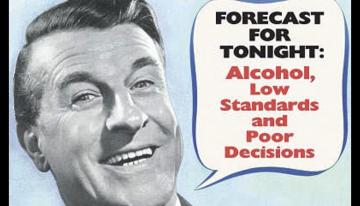Would I Lie to You?
POSTED ON 06/01/2016“Look into my eyes, can't you see they're open wide. Would I lie to you baby, would I lie to you?” Charles And Eddie

Splendide mendax as I’m sure you’re aware, means nobly untruthful or untrue for a specific purpose. It’s the academic equivalent of the white lie and it lends its name to a study which claims that the wine industry is telling porkies about alcohol levels on the label to improve sales. One of the more surprising findings is that higher-priced wines are less honest in their labelling than plonk.
Exploring the extent to which the alcohol content of wine has risen over time, the study, by Julian M. Alston and colleagues in the Journal of Wine Economics, finds that the average actual alcohol content of the 90,000-odd samples tested from the Liquor Board of Ontario was found to be 13.56 per cent as against an average reported alcohol content of 13.15 per cent: an average discrepancy of 0.42 percentage points.
The survey is not new in telling us that alcohol levels have risen between one and two per cent over the past couple of decades, with the fastest growth in alcohol content coming from Australia and the United States. Of greater interest is the data on rising alcohol levels by country and region and the extent to which the report claims that each country is economical with the labelling truth (Germany is excluded). The sneakiest countries include Chile, Argentina, Spain, and the United States, while the frankest are Portugal and New Zealand.
If we accept, as Alston & Co claim, that rising alcohol levels are more to do with man-made factors than climate change, there are undoubtedly sound wine production-based reasons for this. I’m not talking about a Robert Parker-led conspiracy for fuller-bodied silkier reds so much as improved vineyard management and winemaking techniques aimed at fulfilling the winemaking Holy Grail of riper tannins and better flavours.
However, consumers happy to be getting more flavour in their wines are considerably less enamoured with the resulting higher alcohol. It creates a perception of wines that are unbalanced and lack that essential refreshment factor, and it raises concerns over health and legal driving limits. This fear of rising alcohol levels has led to a volte face by consumers looking increasingly for refreshment and balance in their wines and for that reason alcohol labelling is one of the big issues du jour.
Predictably, the wine industry has hit back, saying that this is a non-story because it’s legal to put a lower alcohol declaration on the label if it’s within the tolerance level permitted by the relevant country. In the EU the tolerance level is 0.5 per cent in either direction for table wines while it varies in other countries. The US for instance permits one per cent on wines over 14 per cent alcohol, and 1.5 per cent on wines under 14 percent; Australia and New Zealand allow 1.5 per cent.
To try to sweep the report's claims under the carpet rather misses the point. The report is not just about rising alcohol levels or even labelling misinformation, but rather, it’s about motive. Alston & Co. claim that to deal with the consumer backlash against higher alcohol levels, the wine industry is deliberately misleading us by understating alcohol levels on the label both for marketing and tax purposes. If it’s true that we choose to pay winemakers to lie to us, as they claim, then we ought, at the very least, to be aware of it.
The Wine Gang
6 January 2016

